Education?
Occupational Therapy programs have an increased need for advanced systems to track what students learn in the classroom and the level, quality, and variety of fieldwork experiences as defined by the ACOTE standards.
Meet Technology.
eMedley for Occupational Therapy caters to these specific needs and requirements by helping to ensure that accreditation standards are met, competencies are tracked, and student mastery and performance is measured.
Education?
Occupational Therapy programs have an increased need for advanced systems to track what students learn in the classroom and the level, quality, and variety of fieldwork experiences as defined by the ACOTE standards.
Meet Technology.
eMedley for Occupational Therapy caters to these specific needs and requirements by helping to ensure that accreditation standards are met, competencies are tracked, and student mastery and performance is measured.
Features
Curriculum Mapping
Map course objectives and learning experiences to preloaded ACOTE Standards, NBCOT Domains, and custom program objectives.
Gap and Overlap Analysis
Identify gaps and overlaps in course instruction tied back to domains and standards mapped throughout the curriculum.
Assessment Administration
Manage question banks, tests, and remediation while administering secure tests and tracking student performance tied to specific OT standards and domains.
Announcements
Ensure students and faculty are getting the information and announcements needed for success.
Evaluations
Measure student, faculty, and instructor performance tied to fieldwork learning experiences and curriculum effectiveness.
Fieldwork Experience
Tracking the quantity, quality, and variety of students’ fieldwork experiences.
Scheduling
Color-coded schedule planner to easily manage and visualize the fieldwork schedules.
Mail Merge
Built-in mail merge to send correspondence to students, fieldwork sites, and instructors.
Documentation
Easily track paperwork, documentation, and contacts for students, faculty, instructors, and fieldwork sites.
Automatic Reminder
Keep the program up-to-date on anything that is expiring — affiliation agreement, instructor licenses, student documentation, etc –with automated reminders.
Data Analysis
Access reporting tools to answer key questions such as: Where are we covering specific standards? How are students performing related to what we are teaching?
Evidence Based Curriculum
Track how content is getting covered, how learning will be assessed, and specific examples of instruction methods and tools.
Features
Curriculum Mapping
Map course objectives and learning experiences to preloaded ACOTE Standards, NBCOT Domains, and custom program objectives.
Gap and Overlap Analysis
Identify gaps and overlaps in course instruction tied back to domains and standards mapped throughout the curriculum.
Assessment Administration
Manage question banks, tests, and remediation while administering secure tests and tracking student performance tied to specific OT standards and domains.
Announcements
Ensure students and faculty are getting the information and announcements needed for success.
Evaluations
Measure student, faculty, and instructor performance tied to fieldwork learning experiences and curriculum effectiveness.
Fieldwork Experience
Tracking the quantity, quality, and variety of students’ fieldwork experiences.
Scheduling
Color-coded schedule planner to easily manage and visualize the fieldwork schedules.
Mail Merge
Built-in mail merge to send correspondence to students, fieldwork sites, and instructors.
Documentation
Easily track paperwork, documentation, and contacts for students, faculty, instructors, and fieldwork sites.
Automatic Reminder
Keep the program up-to-date on anything that is expiring — affiliation agreement, instructor licenses, student documentation, etc –with automated reminders.
Data Analysis
Access reporting tools to answer key questions such as: Where are we covering specific standards? How are students performing related to what we are teaching?
Evidence Based Curriculum
Track how content is getting covered, how learning will be assessed, and specific examples of instruction methods and tools.
Process
Ask the right questions at the right time.
1. Map Curriculum
What are we teaching? Which disciplines and competencies are being covered? How much are we covering?
2. Analyze Learning & Objectives
Are students learning what we think they should be from a variety of learning experiences?
3. Administer Performance-Based Assessments
How well do students transition from knowledge to application?

4. Analyze Experiences
Can students successfully perform in the field based on the concepts learned in the classroom
5. Evaluate Experiences
How can we get useful feedback on fieldwork sites, students, and instructors? Build custom evaluation forms to gather program specific data.
6. Curriculum Review and Analysis
How well do students apply knowledge to application? Review assessments and evaluations to find learning gaps and overlap.
Process

Ask the right questions at the right time.
1. Map Curriculum
What are we teaching? Which disciplines and competencies are being covered? How much are we covering?
2. Analyze Learning & Objectives
Are students learning what we think they should be from a variety of learning experiences?
3. Administer Performance-Based Assessments
How well do students transition from knowledge to application?
4. Analyze Pre-Fieldwork and Fieldwork Experiences
Can students successfully perform in the field based on the concepts learned in the classroom?
5. Evaluate Experiences
How can we get useful feedback on fieldwork sites, students, and instructors? Build custom evaluation forms to gather program specific data.
6. Curriculum Review
What should we change with our curriculum to improve performance? Review assessments and evaluations to find learning gaps and overlap.
Highlights

Minimize the time dedicated to the collection, analysis, and application of student performance data to inform strategic decisions and improve instructional practices.
Optimize scheduling with a system built specifically to help health science education programs schedule rotations with intricate rules.


Track the amount, quality, and variety of fieldwork experience.
Measure and track student performance that map to competencies and standards.


Centralize graduation requirements, fieldwork experience requirements, and other essential student data into one single location.
Highlights

Minimize the time dedicated to the collection, analysis, and application of student performance data to inform strategic decisions and improve instructional practices.

Optimize scheduling with a system built specifically to help health science education programs schedule rotations with intricate rules.

Track the amount, quality, and variety of fieldwork experience.

Measure and track student performance that map to competencies and standards.
